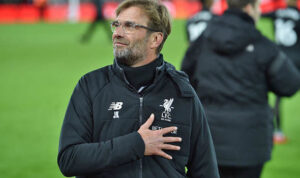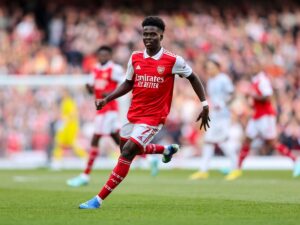Declan Rice: Defending the midfield
West Ham United midfielder Declan Rice is among the most highly regarded players in his position; a complex, demanding and fascinating position that justifies and deserves a proper breakdown.
The position goes by different names – the 6 or ‘defensive midfield’ usually – and can incorporate different styles of play, player profiles, roles and responsibilities. As there are different names for the 6, there are different ways to play it too. Declan Rice typifies and demonstrates one of these.
Defending the midfield
The role Declan Rice occupies, at least up to now, is one of a midfield defender: playing between midfield and defensive lines. This number 6 engages in active defensive work – tackles, duels, interceptions – in order to supplement the defensive line. He attacks opposition offensive moves and looks to win possession. More defensively proactive than a centre back, more defensively focused than a central midfielder.
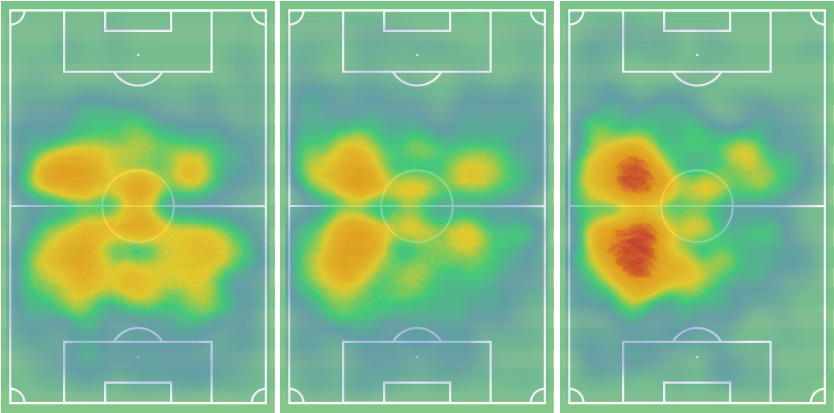
Through the course of this analysis, we will see that Rice is not limited to being a defender; he is not a centre back being forced out of position. He is a capable ball-playing midfielder too and possesses strengths that carry well into his offensive and creative capacities. But most of all, the real focus is on Declan Rice the defender.
Positional play
A good place to start for any defender is where they put themselves and on the pitch and why. When you’re defending, good starting positions will do most of your job for you.
There’s a lot to go through in terms of positioning in every game. You can isolate strong examples to present a player as an intelligent, aware positional defender; and you can present the opposite by demonstrating the times a player is caught out – through fault or circumstance. There are many examples of both good and bad in every game for every player.
I’ve isolated a few examples from three of West Ham’s more recent fixtures in the Premier League. Through these examples you can see the kind of focus Rice has in his off the ball work; the kind of areas he wants to pick up, cover, and ultimately protect. Cover and protection – particularly protection – are key words when looking at defensive positional work. You are guarding an area, blocking passing lanes, covering routes between lines.
Long legs on a powerful frame allow Rice to cover large spaces relatively quickly. He isn’t a sprinter, but he has the kind of sustainable, quite deceptive speed of a tall athlete. While the legs aren’t necessarily moving quickly, the whole unit usually is.
Being a part of the midfield (rather than the defensive line) means Rice isn’t always facing play. When the midfield is bypassed, Rice is bypassed, and he then has ground and, therefore position, to make up. There are a number of examples where the ball is played through or between players and Rice is engaged in a foot race to take up position in key space faster than the attacker is able to exploit it.
Other times, the discipline Rice shows and the general (and apparently natural) focus he has on the defensive game means he is behind play during opposition transitional or positional attacks and is able to function more as a defender without the need for frantic midfield athletics.
In West Ham’s recent 1-0 win over Tottenham, we can see both instances.
Whether it comes about through strong covering runs and athleticism, or discipline and reservation, when Rice is able to occupy defensive position, he tends to do it very well.

With a lot of scanning (technical, quite pretentious way of saying ‘pivoting his head and looking around a lot’) Rice is aware of his surroundings and is able to place himself central in a potential danger area. He gives himself the chance to react when the ball is eventually played. He doesn’t take himself out of the game by committing early. This is an example of centre back defending in a centre midfield position.
If we look at West Ham’s win over Everton, we can see a similar kind of thing but in a more typically ‘centre back’ way.
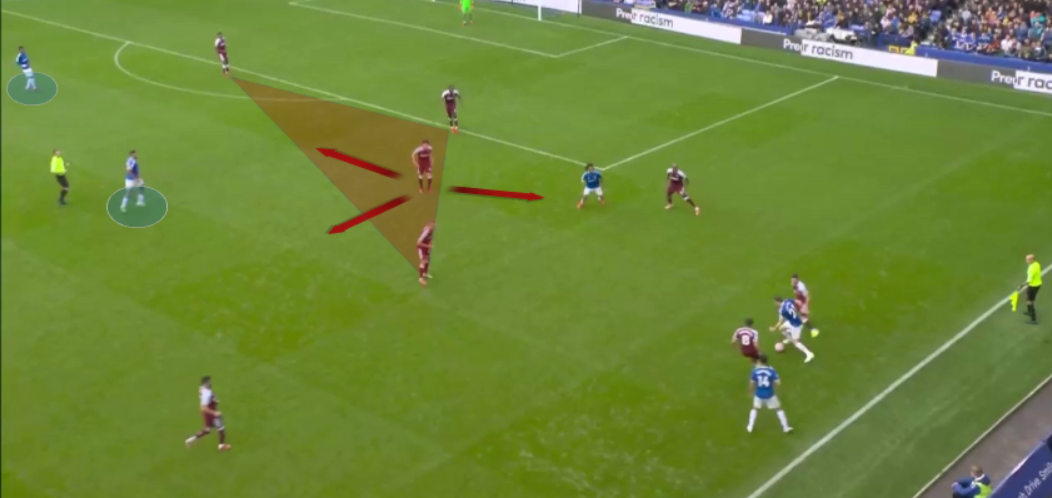
Here we find Rice between his own midfield and defensive lines in a kind of defensive free role. He is marking space rather than any particular player. The space he has decided to mark incidentally allows him to cover two options. He is blocking the passing lane to the edge of the area between the West Ham lines – likely the best option for Everton – and he is close enough to two players to engage either should the ball be accurate played into one of them.
It’s another example of Rice hedging his bets in order to strike when the moment best presents itself. In order to commit with the kind of aggression he does, Rice must first make sure he is well prepared for it.
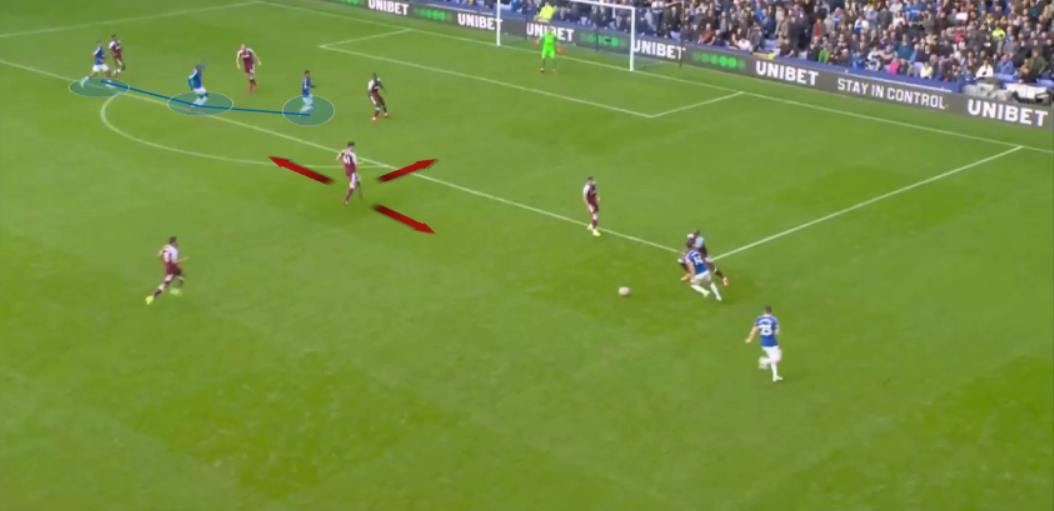
Here he is in a similar situation, marking his space while his defensive line picks up each of the three attackers man-to-man. Rice is positioned to defend a pass ahead of his defensive line – if an attacker drops off to receive the ball – and also to defend the near post space. He could even engage the ball carrier himself if the Everton forward is able to shake off his marker.
It’s simple and effective. By simply standing somewhere effective, Rice is already performing a good share of the defensive work. It is his job to make life difficult for the attacker, to close options and shut down possible routes to goal.
Throughout the four minutes worth of clips compiled, you will see further examples of this style of anticipatory positional defending in deep as well as more advanced middle third areas. You will also see Rice occupy spaces closer to his own goal, usually at the near post, in order to put himself in the way of the ball should the need arise for more active, perhaps more noticeable old fashioned defensive work.
Active defending
Having seen the positions from which Rice attacks his defensive duties, we can look at some of his active ball-winning defensive work, revealing a little about how he makes them possible. After all, putting yourself in a position to perform well is only worth as much as your final performance.
Across six seasons, a little over 18000 minutes in all competitions for club and country, Declan Rice wins 64% of his 6.7 defensive duels per 90. He wins 49% of his 2.9 loose ball or ’50-50′ duels, and commits 0.7 fouls per 90.
Commitment is a word we’ve used a lot so far and it’s a useful focal point for the way Rice goes about his defensive work. Active is another one. The idea of active commitment is a big part of his game. Rice commits fully to his defensive actions, he tends to throw himself into challenges when the opportunity presents itself and the time is right.
The clips presented in the compilation show the good, solid, successful actions; I don’t want to portray Rice as an infallible defender, he sometimes gets it wrong and this sometimes puts his team in trouble. The kind of commitment he shows, the act of throwing yourself into things, tends to open yourself up to error. For example, Rice ranks in the top 10% of European players to be beaten by a dribble per 90 over the past 12 months, and his errors leading to a shot rank him in the top 65%.
It’s important to remember that proactive, aggressive defending leaves little margin for recovery. If you commit totally, there is usually no real chance of immediate redemption. In Rice’s case, he gets it right more often than he doesn’t, and his intelligent, thoughtful, far more considered preparatory positional work is mostly responsible for this. His awareness and decisions are good to make the call, his athleticism is good to cover the ground, and his timing and technique work well in the execution, but what really allows Rice to defend as effectively as he usually does is his positional play.
We can see this best illustrated in Rice’s recorded interceptions in his recent fixtures – Everton, Brentford, and Manchester United. Especially how his positional work permits the active defensive work.
Over that substantial six-season sample, Rice averages 5.3 interceptions and 9.8 ball recoveries per 90. His interceptions rank him in the top 4% of players.
This is where Rice really excels. He is a good tackler, a strong physical battler, but he is excellent at moving ahead of a ball receiver or moving into a passing lane, anticipating the pass and intercepting it. Rice has a real talent in making a perfectly normal, generally accurate short pass from an opposition player look like an error.
Aerial duels
While Rice is a strong athlete, long-limbed and quick to cover ground, with good upper body strength and balance, he isn’t particularly naturally strong in aerial battles. At 6’1” (185cm), Rice is tall but not the kind of tall that works to single him out among others in his position. He isn’t tall enough for his height to be a genuine advantage.
I’ve compiled a number of his successful aerial duels in more recent games but it’s important to note that he doesn’t compete for many of these (2.8 per 90 since 2016) and he wins just over half of them (56%).
Rice is defined by his defensive work, but this is quite limited to the work performed on the ground with his feet. He can compete aerially, there is potential for this to develop into a real strength, but he isn’t there currently. It is not a natural strength of his.
As we’ve seen already, he is a natural athlete. He is powerful when moving at speed and his timing, as well as his spatial awareness, is very good, so this could lend itself well to aerial dominance in the future. But right now it’s not there.
At West Ham, Rice’s defensive midfield partner – the equally impressive 26-year-old Tomáš Souček – performs the lion’s share of the aerial work. The Czech midfielder is taller, more naturally adept at the aerial game, and he simply performs those tasks far more often.
Moving the ball and using the ball
Passing and playmaking
Declan Rice is defined by his defensive work, it would be fair to call him a defender. That is mostly the focus of this analysis. But he isn’t limited to that. He is also perfectly competent playing with the ball at his feet.
His long passing is very accurate (60% of 676 in total), his passing into the final third is extremely accurate (83% of 1327), and his passing into the opposition penalty area is also, contrary to some opinion, also very effective (56% accurate of 170). These particular actions are, understandably, far less frequent.
Rice isn’t a playmaker by trade, he is defensive and focuses his game within that defensive scope, but he is effective with the ball at his feet.
His output for key passes has steadily increased over the past five seasons (0.24, 0.26, 0.33, 0.45, 0.51 per 90 respectively) and this could highlight a process of maturity in Rice’s offensive game.
As he becomes more confident with the ball at his feet and more willing to take risks from defensive areas, he is beginning to have more of a direct say in how his team transitions and attacks. It could also reflect West Ham’s steady improvement under David Moyes with Declan Rice central to the team.
Dribbling and progression
Interestingly, among Rice’s standout attributes in terms of the statistics is his ability to carry the ball. A progressive carry – effectively moving with the ball over a significant distance towards the opposition goal – is an area of the game where Declan Rice, apparently, excels.
He ranks in the top 8% of players for progressive carry distance and the top 18% for progressive carries in total. Considering the player Rice is, and how much of his game is about defending, recovering and releasing the ball, this is quite remarkable. For carries into the opposition final third, Rice ranks in the top 9% of players over the past 12 months.
His dribbling – again leggy, again effective – is remarkably solid. Rice ranks in the top 13% of players for successful dribbles. We can see a few examples of this.
We’re again going back to the realm of using space in order to perform a later action more effectively, as he does with his positional work before committing to a defensive action. Rice is good at beating his first marker, midfielder, the player who decides to engage him, and from there he is able to find and use the space.
Once the player – and likely therefore the first midfield line – is broken, Rice has the option to progress the ball. Either through one of those long passes we’ve seen or through one of his many progressive carries, Declan Rice is able to use the ball well within an early phase offensive capacity from a defensive foundation.
Shooting
Over the past three seasons, Rice has slowly developed a habit of shooting from range. He is definitely not a natural in front of goal, but there are signs of some positive potential, especially through his intent.
We can see from the goals he has scored the way Rice uses his different strengths and versatility to great effect (on quite rare occasions).
He shoots low from range and high from range, he make near post and far post runs from corners and wide free kicks, he makes late runs from the midfield to support dynamic attackers during positional or counter attacks. Rice has shown, especially over the past two seasons, a lot of positive intention in front of goal.
Across the six seasons, his shot accuracy stands at 31% from 109 shots in total. He has scored 10 goals. As we saw with his key passes, the number of shots Rice takes, as well as his shot accuracy, has steadily increased over the past three or four years. Again, this is likely a matter of confidence and maturity. Also possible explained by the improvement in his team overall (especially during the past two seasons).
His shot map for games in the Premier League shows a spread of shots from various distances in the central channel.
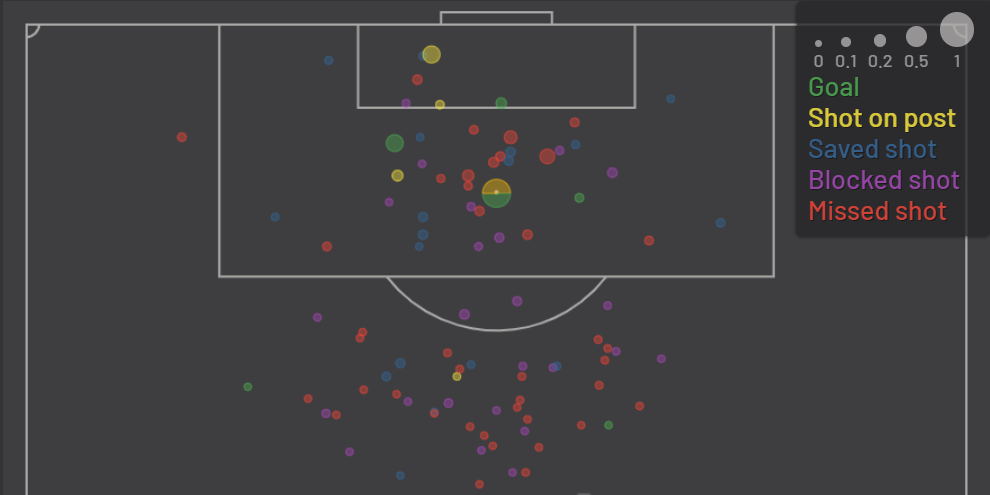
It isn’t until we separate this into shots taken from open play:
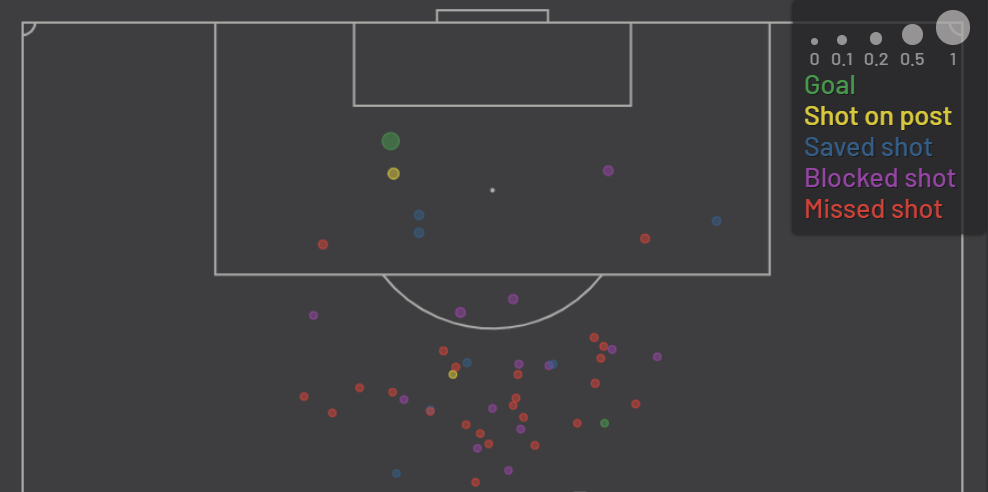 I
I
And shots taken from set-pieces:
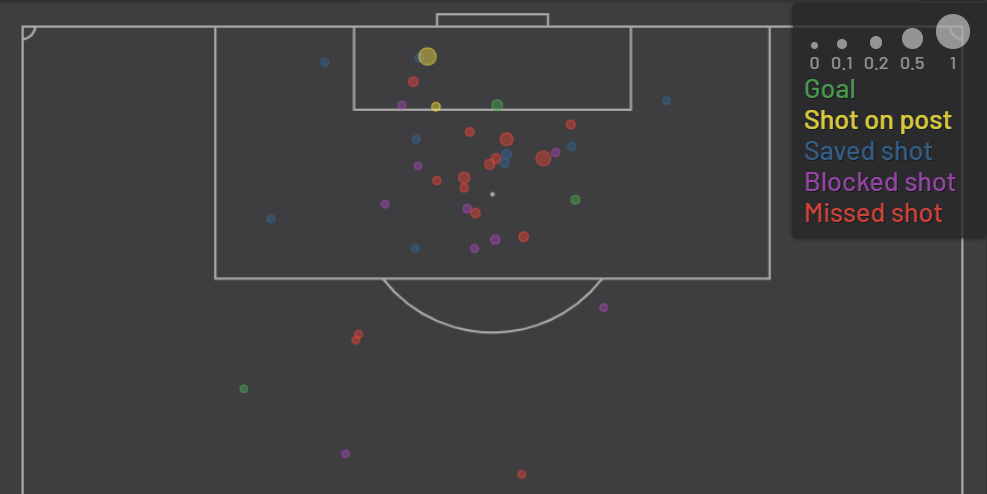
That we begin to see the trend in Rice’s shooting. He is a natural target and danger-man for offensive set pieces, especially under the David Moyes aerial offensive approach; he is keen to shoot from distance when presented with the opportunity when defenders are between him and the goal and when his team is comfortable in possession.
Considering how many of Rice’s shots are taken either from long range or from an inopportune header inside a crowded penalty area, his 31% to 35% range of shooting accuracy since 2019 is quite impressive.
Another area where Declan Rice isn’t exactly a natural, but his intention to shoot at goal, and the general technique he has to find a consistently clean connection with the ball, mean there is potential there for Rice to be an effective threat from ground shots if more opportunities – perhaps better, clearly opportunities – present themself in future.
On top of this, despite not being a hugely tall player, his athleticism and timing make him a natural target for set pieces, and his positional awareness and intelligence in his movement make him a deceptively dangerous attacker in these situations.
Declan Rice
He is a midfielder who defends really well. This is how I feel most comfortable categorising and summarising Declan Rice. We shouldn’t limit him to this. He isn’t a centre back – though he can play there – and he isn’t a dynamic centre mid – though he can do that too; rather Declan Rice is a great defender who is strong enough and versatile enough in his technical and physical game to operate between key positions.
With West Ham (and usually England), Rice is used defensively. If he moves to a club where defensive football takes a secondary role (which is probably likely), then we might see Rice move into a more dynamic number 8 role. Here we would see more of that ball progression and passing range take centre stage. As it is now, the primary function of the player is defending and it is something he does extremely well. But him doing that now does not mean that is all he can do.
He shows plenty of ability in key offensive attributes and he shows even more positive intention and enthusiasm. There is a reasonable cause to believe that Declan Rice may not always be defined as a midfielder who defends, but for now, that is where he is at. And he does it really really well.
